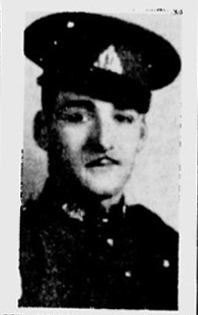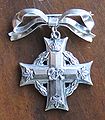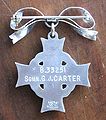Carter, George John
| George John Carter | |
|---|---|
| 12 August 1916 – 24 August 1944 | |
 | |
| Place of birth | Saskatoon Saskatchewan |
| Place of death | France |
| Place of burial | Bretteville-sur-Laize Canadian War Cemetery |
| Allegiance | Canada |
| Service/branch | Canadian Army |
| Years of service | 1939-1944 |
| Rank | Signalman |
Early Life
George's parents, father John Wilson Carter (born about 1875) and mother Alice Carter (born about 1876) were married on 19 July 1897 in Liverpool England. Their first child, Margaret Hilda, was born about 1898 and was soon joined by brothers David Wilson born in November 1900 (David served as a Lieutenant with the Royal Canadian Engineers in British Columbia during the Second World War) and Ralph born in 1902. John emigrated on his own to Canada in 1912, presumably to get settled and prepare for the arrival of his wife and children who joined him in 1914 at Saskatoon Saskatchewan.[1] George John was born on 12 August 1916 at Saskatoon making him the only child born in Canada.
George attended Mayfield & Westmount schools in Saskatoon where he completed 3 years of high school (11th Grade). He attended the Technical Collegiate Institute before moving to Toronto to complete one year of training as a wireless operator at Radio College (Bloor Street).
He had recently completed his program and was working as a salesman and interior decorator for Stewart Allen Co Ltd in Toronto when the Second World War was declared.
Service
George attested for service on 19 September 1939 with 1st Canadian Corps Signals and was assigned regimental number B33251. He was described as being 5' 10" tall, weighing 156 lbs with a fair complexion, brown eyes and dark brown hair. He would have undertaken training in the Toronto area before he proceeded to Barriefield Concentration Camp in November where he was assigned to 3 Army Field Regiment Signal Section.[2]
As he prepared to proceed overseas, George married Marjorie Olive Carter on 7 December 1939 in Toronto. Shortly after, on 30 January 1940, he departed Halifax (HMTE 19), disembarking in Scotland on 9 February. His unit proceeded to Aldershot England where it was to be based for training and preparations.
Things seemed to have gone smoothly for George until August 1940 when he began to run afoul of military rules and regulations. On 11 August he forfeited one day's pay and was confined to base (CB) for seven days for failing to appear at a place of parade (the signal office). The next day he failed to be at defaulter's parade for which he was confined to barracks for three additional days. He was away without leave (AWL) from 2300 hours on 5 September until 0800 hours the next morning for which he forfeited one days pay.
These punishments don't seem to have corrected Signalman Carters behaviours as on 1 October he forfeited a further 8 days pay for missing a military duty. He was again AWL, this time for an extended period, from 2300 hours on 8 October to 1100 hours on 10 October while he was supposed to be confined to base and forfeited his pay for 16 days. Having not changed his ways, he received 14 days confined to base and forfeited two days pay for being AWL from 1600 hrs on 2 November to 1500 hrs on 4 November. On 15 November, for escaping from the guardroom when under close arrest, he received five days of Field Punishment (FP) and forfeited five days pay. His transgressions escalated and on 21 November he received 21 days of detention and forfeited 21 days pay for making away with and selling public property - specifically for selling to H3924 Sigmn P.A. Laverdiere one Haversack Mk V and one Respirator Anti-gas Mk IV for the sum of 10 shillings. He finished out 1940 by forfeiting seven days pay for being AWL from 2230 hours on 14 Dec 40 to 1010 hrs on 18 December and receiving seven days Field Punishment and losing a further 12 days pay for being AWL from 2400 hrs on 25 December to 1000 on 30 December.
Sigmn Carter's run-ins with the military justice system continued in 1941. Being AWL from 2230 hours on 11 January until 0925 hours on the 12th he was confined to base for three days and forfeited one days pay. He forfeited a further six days pay for being AWL from 2230 hours on 22 February until 2000 hours on the 23rd. AWL again from 2230 hours on 25 April until 2200 hours on the 27th, he received five days confined to base, forfeited two days pay and his next privileged leave period was cancelled. Again absent, this time from 2300 hours on 29 June to 2100 hours on 2 July, he forfeited 13 days pay and received 10 days field punishment which he served at the Canadian Corps Field Punishment Camp.
Matters escalated when he was again AWL from 25 July until the 28th. He went before a Field General Court Martial to face three charges: theft; AWL for 2 days 10 hours; and conduct prejudicial to good order and discipline for converting to his own use a War Department vehicle and petrol. He was found guilty on the first and third charges while the AWL charge was withdrawn. His sentence was 112 days imprisonment which he served at Wandsworth Civil Prison. During this period, as a non-effective soldier, he was struck off the unit's strength and transferred to No. 1 Canadian Signals Holding Unit. On 25 October 1941 he returned to 1st Canadian Corps Signals and seems to have stayed out of trouble for the remainder of the year and was granted nine days of privileged leave from 21-30 December.
Sigmn Carter was AWL again on 21 March 1942, for one hour, and forfeited seven days pay and received seven days Field Punishment. A heavy sentence which was no doubt influenced by his previous record. On 6 April he was AWL again and this time forfeited 14 days pay and received 14 days Field Punishment. At this point it was determined that Sigmn Carter might benefit from a fresh start in another unit and so he was transferred to First Canadian Army Signals on 7 April 1942 and assigned to 3 Despatch Rider Section in 2nd Company. In June he was qualified to wear the drivers skill-at-arms badge.
From 11 August until 1 October he attended a course at 1 Canadian Signal Reinforcement Unit. He was again AWL from 2300 hrs 8 November to 1930 hours on 10 November for which he forfeited 2 days pay and was confined to base for seven days. On 15 November he was admitted to No. 6 Casualty Clearing Station and transferred to 14 General Hospital for an undocumented illness. He was discharged on 25 November and was able to rejoin his unit on 11 December. He was granted privileged leave from 13 until 20 January 1943 and again from 5 to 12 May. He was admitted to No. 6 Casualty Clearing Station on 5 June. Later transferred to 10 General Hospital on 10 June, he returned to his unit on 24 June. On 25 June he was reclassified as a Driver Mechanic "C".
On 7 December 1943 Sigmn Carter was served with a maintenance order from the Petty Sessional Court at Beacontres on complaint of Olwen Joan Davis, residing at 45 Coleman Road Dagenham (a suburb of London) for a child born on 3 October 1943. Sigmn Carter accepted responsibility for the child and was ordered to pay £4 for being brought to court, £7/6 for the cost of order and £7/6 per week until the child reached the age of 16 years old. This resulted in his pay being stopped starting 1 January 1944 for the sum of $8.18 per month until end September, $7.31 for October and for $7.26 per month afterwards.
He was granted seven days privileged leave from 2 until 9 February 1944. From 27 February until 3 March he attended a special driving course and on 8 June he was reclassified as a Driver Mechanic (Motor Vehicle) "C". He embarked on 18 June 1944 and proceeded to France where he disembarked on the 20th, two weeks after D-Day.
While travelling to 2 British Army Rear Headquarters on 24 August, Sergeant McDougall and Signalman Carter were reported missing.[3] It was later determined that Sergeant McDougall had been injured and Signalman Carter had been killed. Signalman Carter was initially "scarcely and poorly (as re locations) buried" (location not stated) but was moved sometime by 3 September, with permission, by the unit chaplain to Langannerie Canadian Military Temporary Cemetery at coordinates 7F/4 09435031, nine miles North-West of Falaise on the Caen-Falaise road.[4] He was later re-interned at Bretteville-sur-Laize Canadian War Cemetery at grave V.D.5. after the war when the cemeteries were consolidated by the Commonwealth War Graves Commission.
Related Pages
- No related pages at this time
Related Items
References
- ↑ 1916 Canada Census of Manitoba, Saskatchewan, and Alberta. Year: 1916; Census Place: Saskatchewan, Saskatoon, 03I; Roll: T-21944; Page: 31; Family No: 382
- ↑ Service File, Library and Archives Canada.
- ↑ First Canadian Army Signals War Diary, September 1944, Appendix 13.
- ↑ First Canadian Army Signals War Diary, September 1944, Appendix 11.



